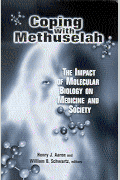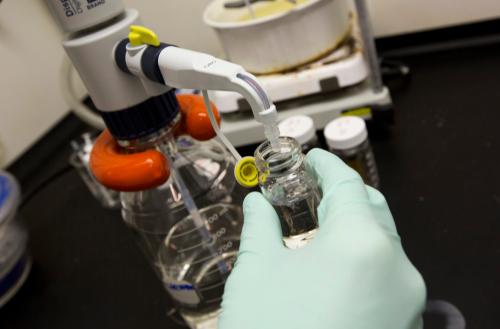The second half of the 20th century witnessed spectacular advances in health care. Innovations such as magnetic resonance imaging, genetically engineered growth factors, and highly effective drugs for the treatment of depression, gastroesophageal reflux, high blood cholesterol, and HIV disease greatly improved the detection and treatment of both rare and common diseases. The advances greatly improved the outcomes of complex procedures such as organ transplantation, coronary artery bypass surgery, and high-dose chemotherapy (bone marrow transplantation) for acute myeloid leukemia and multiple myeloma. As the 21st century opens, technological progress in medicine is continuing and may be accelerating. It is a source of hope for the prevention, effective treatment, and cure of disease.
Technological innovation is also the major source of increases in real per capita medical spending in the United States. If medical advances continue to be adopted as rapidly as they have been, they will pose knotty economic, political, and ethical challenges for health care policy at a time when spending on health care in the United States has once again begun to surge after a mid-1990s pause and the number of Americans without health insurance has once again begun growing.
Innovation and Health Care Spending
Innovations can reduce spending on medical care, but most do not. One government agency attributes nearly all of the age- and price-adjusted growth in per capita medical spending in recent decades to technological innovation. Such innovations often have their greatest impact long after they are introduced, when patients who would have received an older, inexpensive treatment or none at all receive more, or more expensive, care. Such shifts typically occur when the use of a new drug, device, or operation spreads beyond the narrowly defined populations in which it was introduced. For example, middle-aged men with chronic stable angina pectoris were the first routine beneficiaries of coronary artery bypass graft surgery. With experience and incremental clinical innovations, however, the same procedure now benefits patients with other conditions, such as heart attacks, and other demographic groups, such the elderly, initially deemed unsuitable. Although these and other innovations in treating coronary disease may have raised expenditures per patient, they have reduced the price of achieving important health outcomes, such as surviving hospitalization.
The Interaction of Research and Health Care Finance
Federal support of biomedical research (more than $20 billion in fiscal year 2001 for the National Institutes of Health alone) and research investments by manufacturers and other private companies (billions more) stimulate the development of new technologies and approaches to health care, each of which has consequences for health expenditures and outcomes. For-profit corporations invest in research because they expect it to lead to the development of biomedical goods and services that will bring future revenues and profits.
U.S. health insurers directly invest little in biomedical research. But they have a powerful indirect effect on research investment because health insurance influences demand for and revenues from medical innovations. Because insured consumers pay only a fraction of the price of care, price is less important to them than are other characteristics of care, such as convenience, safety, and efficacy—that is, quality. Health insurance increases demand for health care generally, but its most important effect on health care spending may be through its long-term influence on the development of new forms of care. And health-insurance subsidized demand not only raises investment in medical research, but also changes the character of that investment, encouraging research on quality-improving innovations, rather than on cost-reducing ways to accomplish the same health outcomes as older interventions.
Imagine how the market for automobiles would have developed if a third party provided insurance that paid 80 percent of the cost of new cars. The third party recovers the cost of this insurance by taking a portion of each insured person’s earnings. Apart from those without auto insurance, anyone who wanted an automobile could buy one at one-fifth of market price. Such insurance would influence both the number and types of cars people bought. People would replace cars more often and would buy higher-quality cars than they do in today’s car market. A Lincoln or a Mercedes would cost buyers little more than a Chevrolet or a Honda, and sales of luxury automobiles would rise. Auto manufacturers would focus their product development on quality enhancements, such as big engines and luxurious interiors, rather than on cost-reducing manufacturing changes. The quality-adjusted price of automobiles might fall, but because only high-quality cars would be sold, the average price of a car would rise. The costs of car insurance would rise inexorably. The well-insured might welcome the steady improvements in the quality of luxury cars, but many would have been better off with simpler automobiles and higher take-home pay.
There can be little doubt that high spending on health care has encouraged technological innovation that has dramatically improved the well-being of Americans. Most people with health insurance in the United States are surely better off with today’s health care at today’s prices than they would be if they had 1980 health care at 1980 prices. This observation, however, offers little guidance for policy. The appropriate question is whether Americans would be better off today with the medical technologies and health care system that would have resulted if the demand for medical care had been more strongly influenced by price and if biomedical research had been shaped by such a payment system. In that scenario, technological advance would have been different and probably somewhat slower, the price and total cost of health care would have been considerably lower, a larger share of Americans would have been able to afford health insurance, and consumption of other goods and services would have been higher. Overall, welfare might well have been higher.
Averages versus Margins
Debates about technological progress in health care often confuse two distinct issues. One concerns the average improvement in health—are we better off today than in the past? The other concerns marginal improvement—if we spend more on health care, how much better off will we be? We believe that average improvements over time have been large, but that marginal improvements from the last dollars we now spend are small. The progress medical science has made against coronary heart disease is striking, but it is not evidence that implanting a stent (a mesh tube, used to keep partially occluded arteries open) in patients with single-vessel, minimally symptomatic coronary disease is worth the cost. Most proposals for the reform of health care financing and delivery would alter spending and incentives at the margin. They should be evaluated on that basis.
A Dilemma: Making Innovation Affordable Slows Innovation
In the U.S. health care market, government regulation is pervasive, insurance subsidizes consumption, and producers enjoy monopoly power through patents or proprietary information. The goals of health care policy—to provide coverage for the currently uninsured, to hold down health care costs, and to promote innovation—are frequently in conflict.
The desirability of government intervention in the health care market is widely accepted. Government-granted patents, for example, protect manufacturers from competition for several years and allow them to recover development costs. Market exclusivity, maintained under government-granted patents or proprietary information, enables companies to charge higher prices, which make it possible for them to pay for research out of profits. Even classic monopoly pricing, under which all buyers are charged the same high price, might not be sufficient to ensure profits. Sometimes recovering research and development costs requires companies to engage in price discrimination, the practice of setting prices for different buyers according to their willingness to pay. Prices for drugs and medical devices, supported by subsidized demand, may bear little relation to the (often low) cost of production. The market price—the sum of the patient’s copayment and insurance payment—for highly effective innovations with no close substitutes can be very high without seriously eroding demand. Since well-insured patients can pay a great deal, the interaction between insurance and patents on drugs and devices enables companies to make large profits on successful products. Prolonging patent lives and broadening patent protection extends barriers to competition and can greatly increase those profits. But both policies raise prices and thereby curb consumption. Narrowing or shortening patent protection lowers profits and boosts consumption.
This trade-off creates a dilemma. If promoting innovation were not a consideration, consumers would be better off if patents did not exist and any company was free to produce any product. Such a policy, however, would diminish the flow of new drugs and devices by removing much of the incentive to invest in research and development of new products.
The trade-off between maximizing the welfare of consumers today and promoting the future flow of new drugs is at the heart of most policy debates about pharmaceuticals. Policies that would lower drug prices—mandating drug discounts and controlling prices, for example—are worth pursuing only if the immediate benefit from lowering prices and making drugs more widely available today compensates for the harm from reducing the future flow of new products. Those who would maintain or extend current guarantees of market exclusivity and who favor policies to preserve high prices for branded drugs typically emphasize the importance of profits to fund the research that will lead to future products.
Recent and projected increases in drug prices heighten the salience of this trade-off. No simple guidelines can determine how to resolve it. Recent increases in prescription drug spending and the rise of insurance copayments for drugs are both certain to make demand more sensitive to price. People with health insurance will pay a greater share of medication costs out-of-pocket, and the uninsured will pay the entire cost out-of-pocket. The increase in personal payments will tend to reduce consumption of prescription drugs, while the introduction of new drugs will increase consumption. Health plans and pharmaceutical benefits managers are also likely to try to hold down price by negotiating price discounts from drug companies in return for policies that favor the products of those companies. Pharmaceutical companies will find it increasingly difficult to compete on quality alone, especially for drugs and devices that compete with similar products, as consumers themselves demand evidence of value before spending their own funds on health care.
Growth in the number and costs of beneficial drugs and devices is likely to cause political pressure to prevent or attenuate a widening disparity between people who are well insured or wealthy enough to afford innovations and those who are not. Medicine has a long and generally honorable history of price discrimination. Doctors have provided free or heavily discounted care to the needy, and drug companies have charged lower prices to those less able to pay full price. Many recent developments, however, seem to have made traditional price discrimination less feasible. Thinner margins on commercial health insurance contracts have made hospitals less willing and able to provide free or heavily subsidized care. With the rise of bulk purchasing by health plans and pharmacy benefits managers, fewer purchasers have truly price-inelastic demand for pharmaceutical products. Paradoxically, it is the solitary uninsured buyer who must pay undiscounted prices for drugs or for health care.
Current research in genomics is expected to lead to highly effective but expensive therapies. Without a dramatic change in health care financing, only the wealthy and well-insured will be able to afford such innovations when they are first introduced. As the number of health care have-nots grows, the pressure for comprehensive health care reform may increase.
Ensuring Effectiveness of Care
There was a time when serious analysts could argue that “all medical care that is effective should be free to all.” No country can follow that precept today. Eliminating ineffective care, according to some policy advocates, is key to reducing health expenditures. Yet even if ineffective care is readily eliminated, the continued introduction of effective new forms of medical care will guarantee continued growth in spending. The chief problems facing the U.S. health care system today are setting priorities for choosing among effective forms of care and finding the means to pay for such care.
How can the most promising medical advances be developed and made widely available? The first step will be identifying those that are most promising. The Food and Drug Administration evaluates the safety and efficacy of new interventions, but not their effectiveness in alternative clinical settings or their cost implications. Today such information, when available at all, is often fragmentary. Several organizations—the Evidence-Based Practice Centers of the Agency for Healthcare Research and Quality, the Cochrane Collaborative, the Blue Cross-Blue Shield Association, Kaiser-Permanente and other health plans, and some large provider groups—assess medical technologies. The heavy preponderance of private-sector efforts is less a sign of thriving private initiative than of inadequate government funding. Although these efforts produce a great deal of reliable information about the effectiveness and value of new medical technologies, the information is neither comprehensive nor readily accessible to the public. There is a compelling need for a large, independent agency to carry out technology assessment in health care. A new center for assessing new and existing technologies could help physicians, hospital administrators, private insurance companies, government agencies, and the public distinguish the truly valuable innovations from those that provide small or no benefit at great cost.
We recommend creating a National Center for the Assessment of Medical Technologies, with an annual budget of $1 billion, financed by a small levy (less than one-tenth of 1 percent) on all health care spending. The National Center would sponsor and conduct research and serve as a repository for diverse data and health information. It would help develop and disseminate systematic knowledge about the effectiveness and value of medical technologies, providing the information that health care providers and patients need to make decisions about when to use both new and established technologies.
The source of funding for the center is critical. There is little chance that such a center could be financed through private, voluntary contributions. The temptation for individual firms and organizations to “free ride” on the contributions of others would be too great. On the other hand, a conventional government agency, subject to the vagaries of annual appropriations and vulnerable to political pressures whenever research results ran contrary to the interests of powerful political constituencies, would lack the independence essential for its dual missions—that is, to develop and disseminate systematic knowledge about the value of medical technologies and, through credible evaluations, confer legitimacy on the efficient delivery of care.
Sometimes the most important contributions of scientific advances are not embodied in treatments and diagnostic procedures. Scientific advances can lead to new insights into the best ways to use existing technologies—or to modify behaviors—to improve health. A particular genetic variant associated with a disease like rheumatoid arthritis, for example, might trigger disease only in people exposed to high levels of certain amino acids. The best preventive might be dietary restrictions rather than gene therapy or a targeted drug. Because most diseases result from an interaction of genes and the environment, there will usually be multiple potential targets for intervention. The best approach should be determined by considering both the effectiveness and the cost of all promising alternatives, whether it is modifying a gene or its products or something as simple as a change in diet or an exercise regimen.
Because the gene-environmental interactions that seem to underlie much chronic disease are difficult to study, particularly when multiple genes contribute to the risk of disease, discovering the best approach to treatment will often be expensive. A pharmaceutical or device manufacturer might readily support research on the effectiveness of its product, whether the motivation is a regulatory requirement or simply an opportunity to demonstrate that its treatment is best. But there is no similar payoff from research on nonmedical approaches to disease prevention or even to research on the effects of generic drugs. Without a profit incentive, investigating the interactions between genes and the nonmedical determinants of health will require public support from government and private foundations.
The Challenges Ahead
Identifying the best approaches to care is a necessary first step, but this information must be used to be effective. The next step is to find ways to pay for effective care. Even with improved information about new technologies, the combination of medical innovation and the aging of the baby boomers will almost surely lead to further increases in health care spending. In the coming decade people will pay a larger share of health care bills in the form of higher insurance premiums and especially more out-of-pocket payments. The higher out-of-pocket payments will encourage people to use the forms of care that they believe to represent the best value, but this trend will also widen inequality in the use of health care.
A thoughtful response to rising inequality will not simply strive to equalize use. Some forms of care are more important than others. The societal interest in equal access to interventions that substantially reduce mortality or prevent disability is much greater than it is for marginally effective interventions. Furthermore, access to medical care must be balanced against other societal needs including support for the poor, education, housing, and public safety.
We face a world of medical opportunity and challenge. In the coming decade, dilemmas posed by the health care system will test our values, our institutions, and our ability to apply rationality and compassion to intractable problems—not to solve them, but to do better than we now do.



Commentary
Medical Innovation: Promises & Pitfalls
January 1, 2003